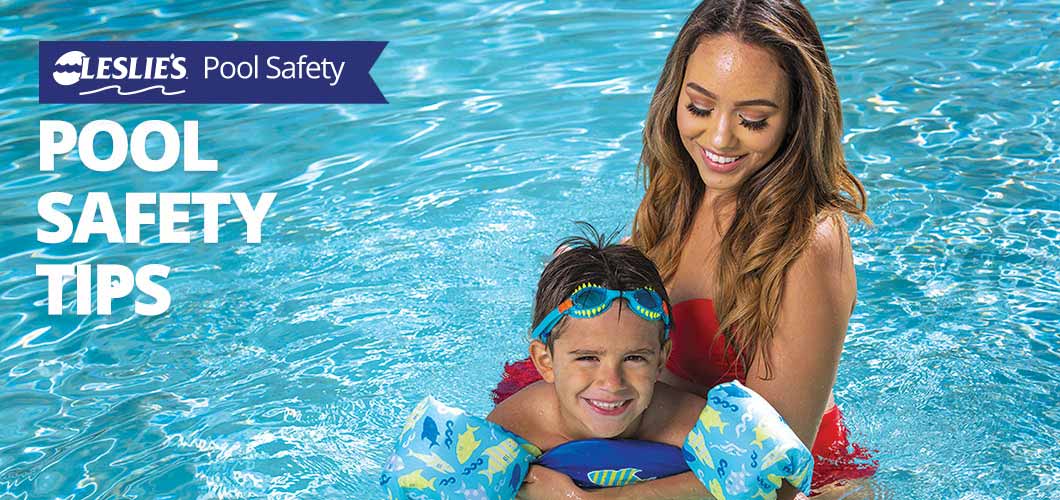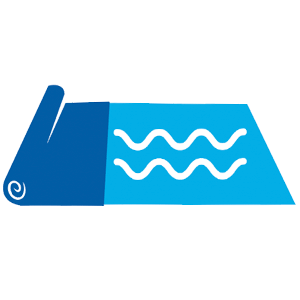
Swimming Pool Safety Tips
Owning a pool can be rewarding in many ways. Not only are they incredibly fun to use, but they’re a valuable recreational tool and can make the “dog days of summer” more bearable. However, there are some important pool safety tips all pool owners should know to keep their loved ones safe — both in and out of the water.
Highlights include:

Installing a pool fence

Installing an alarm

Using a pool safety cover

Having safety equipment available

Testing and balancing your pool water
Pool Safety Equipment
Before we dive into our safety tips and video below, let’s look at some of the most common accessories and equipment needed to ensure a safe swimming pool environment:
- Pool Fence: Installing a fence around the perimeter of your pool will discourage unwanted neighborhood swimmers and help keep young children and animals from entering the water unattended.
- Alarms: Several types of alarms are available, from door and gate alarms that sound when opened, to in-pool alarms that detect disturbances in the water.
- Pool Safety Cover: These sturdy pool covers are made to keep pets and children from falling into the water. Safety covers are most commonly used during the winter months.
- Life Saving Ring & Safety Signs: Let your safety rules be known, and be prepared. It’s a good idea to keep a safety ring or shepherd's hook readily available.
- Test Strips or Test Kit: Healthy, safe, and balanced water makes for happy, healthy swimmers!
Pool Safety Tips for Children
The first and most important rule of water safety is to ALWAYS watch your kids around water. If you cannot give them your undivided attention, have them get out of the water until you can. Another way to help safeguard your family against swimming pool accidents is to teach your kids to swim. Infants can start lessons as young as 4 months old. Learning to swim reduces the risk of drowning by 88 percent for children under 4 years old.
NOTE: There are products designed to introduce kids to water, and swim aids to help while learning to swim, but these do not take the place of formal lessons.
It’s important to have clear expectations for family and friends using the swimming pool. Set up some basic rules to follow whenever you, your children, or visitors are near the pool. Common safety rules include no running, no horseplay, and no dunking. Make sure everyone knows to check their surroundings before jumping into the water; don’t allow children to dive in unless they have permission from an adult.
Safeguard the Pool Area
Owning a pool comes with the responsibility to keep others safe around it. Part of this includes securing the area. Most city and state ordinances require at least a 4- or 5-foot high safety fence around the pool. Install self-closing and self-locking gates, and use a gate alarm and/or pool alarm for added protection. The gate must always open away from the pool. Other requirements may apply. Check with your municipality for pool and spa barrier requirements. We have more info in our Ultimate Swimming Pool Fencing Guide.
You can also secure the pool with a safety pool cover. These custom-fit covers are made of tightly woven material, and are rigid enough to keep kids and pets from falling into the water. In fact, most safety cover companies advertise their product with a photo of a car or an elephant in the middle of the cover. They’re that tough! Though most commonly used during the winter months, many pool owners prefer the peace of mind that comes with using a safety cover year-round.
DIY TIP: Safety covers work really well to keep your pool clean, clear, and free of debris.
Maintain Healthy Pool Water
No one wants to swim in dirty water, and it can actually be bad for your health. Before diving in, make sure your pool water is safe, sanitized, and chemically balanced by testing it. It’s easy to use an at-home water test kit or test strips, or you can take advantage of Leslie's free in-store AccuBlue® water testing to get a complete analysis and customized treatment plan.
Proper filtration and circulation play a big part in keeping pool water clean and healthy. Be sure to maintain your equipment, and clean your pump and skimmer baskets regularly. It’s important to check for any unwanted debris in your skimmer basket before swimming.
Sanitary pool water is so important in maintaining pool safety. Follow a regular treatment plan with primary sanitizer and weekly shock, and monitor chlorine levels with at-home testing. However, some germs that make people sick can live even in chlorinated pool water, so the CDC recommends the following four steps to prevent contamination:
- Stay out of the water if you’re even a little bit sick.
- Shower before you get into the pool to remove dirt and oils from your body.
- Don’t use the pool as a bathroom — do we really have to explain this one?
- Don’t swallow pool water. Just a single mouthful of tainted water can make you sick.
Taking the time to follow these guidelines will help keep your family and friends safe while in or around your pool. For even more swimming pool safety tips, stop by your local Leslie’s, or visit www.poolsafely.gov.